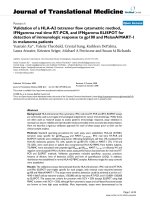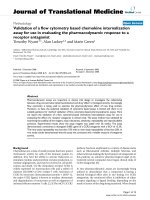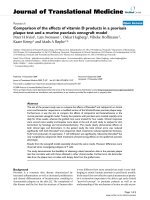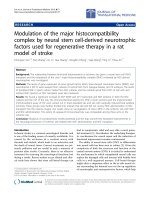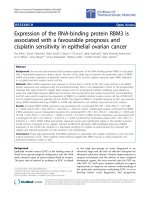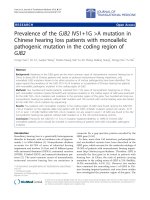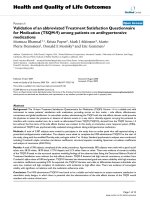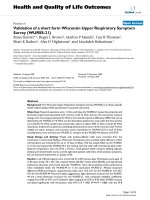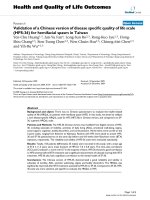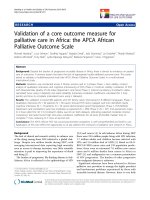báo cáo hóa học: " Validation of a French language version of the Early Childhood Oral Health Impact Scale (ECOHIS)" ppt
Bạn đang xem bản rút gọn của tài liệu. Xem và tải ngay bản đầy đủ của tài liệu tại đây (223.29 KB, 7 trang )
BioMed Central
Page 1 of 7
(page number not for citation purposes)
Health and Quality of Life Outcomes
Open Access
Research
Validation of a French language version of the Early Childhood Oral
Health Impact Scale (ECOHIS)
Shanshan Li, Jacques Veronneau and Paul J Allison*
Address: Faculty of Dentistry, McGill University, Montreal, Canada
Email: Shanshan Li - ; Jacques Veronneau - ; Paul J Allison* -
* Corresponding author
Abstract
Background: An English language oral health-related negative impact scale for 0–5 year old infants
(the Early Childhood Oral Health Impact Scale [ECOHIS]) has recently been developed and
validated. The overall aim of our study was to validate a French version of the ECOHIS. The
objectives were to investigate the scale's: i) internal consistency; ii) test-retest reliability; iii)
convergent validity; and iv) discriminant validity.
Methods: Data were collected from two separate samples. Firstly, from 398 parents of children
aged 12 months, recruited to a community-based intervention study, and secondly from 94 parents
of 0–5 year-old children attending a hospital dental clinic. In a sub-sample of 101 of the community-
based group, the scale was distributed a second time two weeks after initial evaluation. Internal
consistency was evaluated through generation of Cronbach's alpha, test-retest reliability through
intra-class-correlation coefficients (ICC), convergent validity through comparing scale total scores
with a global evaluation of oral health and discriminant validity through investigation of differences
in total scale scores between the community- and clinic-based samples.
Results: Cronbach's alpha for both the child and family impact sections was 0.79, and for the whole
scale was 0.82. The ICC was 0.95. Mean ECOHIS scores for parents rating their child's oral health
as "relatively poor", "good" and "very good" were 10.8, 3.4 and 2.7 respectively. In the community-
and clinic-based samples, the mean ECOHIS scores were 3.7 and 4.9 respectively.
Conclusion: These results suggest this French language version of the ECOHIS is valid.
Background
Children under five years of age can have many oral
health problems, such as teething pains, early childhood
caries (ECC) and dental trauma. Among these childhood
oral health problems, ECC is common in many industri-
alized countries. However, the impact of oral ill-health on
the functional, social and psychological well being of
young children and their families has not been thor-
oughly investigated [1-3]. To do this, oral health-related
quality of life (OHRQoL) instruments are required. In
recent years OHRQoL instruments designed to investigate
the impacts of oral health problems in children have
begun to emerge [4-10], although until most recently,
these instruments have been for 6–14 year old children.
However, for children aged 0–5 years, an English language
instrument to assess oral health-related negative impacts
has recently been developed in the United States [11]. As
with many such instruments, the Early Childhood Oral
Published: 22 January 2008
Health and Quality of Life Outcomes 2008, 6:9 doi:10.1186/1477-7525-6-9
Received: 23 July 2007
Accepted: 22 January 2008
This article is available from: />© 2008 Li et al; licensee BioMed Central Ltd.
This is an Open Access article distributed under the terms of the Creative Commons Attribution License ( />),
which permits unrestricted use, distribution, and reproduction in any medium, provided the original work is properly cited.
Health and Quality of Life Outcomes 2008, 6:9 />Page 2 of 7
(page number not for citation purposes)
Health Impact Scale (ECOHIS) was developed in English
and requires translation and validation in other languages
if it is to be used in these alternative languages. We were
interested in performing such work because we wanted to
use the ECOHIS instrument to describe oral health prob-
lems in infants in Quebec, be able to make comparisons
between oral health impacts in infants in Quebec and
those elsewhere and also to potentially use the instrument
as a tool to evaluate interventions. The goal of the study
reported in this paper was to develop and validate a
French language version of the ECOHIS so that it could be
used among French-speaking populations. The specific
objectives of the work reported in this paper were to trans-
late the English version into French and then investigate
the comprehensibility, internal consistency, test-retest
reliability, convergent validity and discriminant validity
of this French version of the ECOHIS.
Methods
The instrument
Details of the ECOHIS development and validation in its
original English language version are reported elsewhere
[11]. In summary, the instrument is reliable and able to
discriminate between children with different levels of car-
ies experience [11]. This ECOHIS consists of 13 questions
and has two main parts: part one is the child impact sec-
tion and part two is the family impact section. In the child
impact section, there are four domains: child symptom,
child function, child psychology, child self-image and
social interaction. In the family impact section, there are
two domains: parental distress and family function. The
scale is scored using a simple Likert frequency type scale,
with responses ranging from "Never" to "Very often"
(equivalent to scores of 0–4) plus a "Don't know" option.
Item scores are simply added to create a total scale score.
This system creates a scale score range of 0–52, with
higher scores indicating greater impacts and/or more
problems.
Translation into French
The ECOHIS was translated into French using the well-
recognised forward-backward translation technique [12].
The process consisted of several stages. Firstly there was
forward translation from English into French by two indi-
viduals whose first language is French, working independ-
ent of each other. Secondly, the two initial French versions
were compared and revised through a consultation proc-
ess involving the two translators and the principal investi-
gator. Then the third French version produced by this
process was back translated by two individuals whose first
language is English, again working independently.
Finally, the two back-translated English versions were
compared with the original English version and final
adjustments to the third French version made through
consultation with all the translators involved, plus the
principal investigator. This process resulted in a fourth
French version of the ECOHIS, which was pilot tested in
the target population so as to investigate the scale's com-
prehensibility, focusing on the wording of the items and
the responses. This was a qualitative process among a con-
venience sample of 20 parents. This stage resulted in the
revision of one item prior to the scale being ready for for-
mal psychometric testing of its validity. A final point for
the translation was that in our study, the referral time for
the questions was the previous two weeks. This was differ-
ent to the original instrument, which referred to the
child's entire life. We chose a two week period because we
were using the instrument in a prospective study with
repeated, periodic evaluations, so a short term reference
period rather than life time was more pertinent.
The samples
Data used in the analyses reported in this paper came
from two separate samples. Firstly, data were collected
from 398 caregivers of children aged 12 months recruited
to a community-based intervention study, and secondly
from 94 parents of 0–5 year-old children attending a hos-
pital clinic for dental treatment. In both samples, to be
included, caregivers had to live with the child concerned
50% or more of the time and be comfortable reading and
speaking French. This meant that they said "yes" when
asked the question "Are you able to read and speak
French?" and that they were able to read and sign a French
language consent form. In the clinic-based sample, car-
egivers and their 0–5 year old children were approached
while attending a children's hospital dental clinic for
treatment of a "dental problem". "Dental problem" was
defined through caregivers response to the question
"Does your child have a dental problem that requires
treatment?". The possible responses were "yes" or "no"
and those responding "yes" were eligible for recruitment.
Also, a sub-sample of 101 of the community-based group
was mailed the French ECOHIS a second time two weeks
after initial evaluation (with follow-up telephone calls for
those who had not returned this second evaluation), to
enable the evaluation of test-retest reliability. Socio-
demographic data concerning the children and their car-
egivers were collected using self-complete questions rou-
tinely used in government surveys in Quebec. Data from
these two samples are reported in Table 1. All parents
recruited to this study signed a consent form. The study
was submitted to and provided ethical approval by the
Institutional Review Board of McGill University.
Validation of the French version of the ECOHIS
Convergent validity
In order to examine convergent validity, an extra global
oral health question ("Overall, how would you rate your
child's oral health status?") was added at the end of ECO-
HIS. The possible responses to this question were "very
Health and Quality of Life Outcomes 2008, 6:9 />Page 3 of 7
(page number not for citation purposes)
good" "good" "fair" "poor" "very poor", and scores of 1–5
respectively were assigned to the aforementioned
responses. Convergent validity was evaluated through
investigating the correlation between ECOHIS total scores
and the rating of the global oral health question, plus
evaluating difference in mean ECOHIS scores by oral
health status rating category. These analyses were per-
formed with data from the community-based sample,
using total ECOHIS score as a whole and child and parent
impact sections separately. The underlying hypothesis was
that parents who report high level of impacts in the scale
should report poorer overall oral health than parents
reporting low levels of impacts.
Discriminant validity
Our hypothesis was that the ECOHIS should be able to
discriminate between children in the community with no
immediate need for dental care and those in a dental
clinic with an expressed need for dental care. Therefore,
participants recruited from the community should have a
lower ECOHIS score than participants with an expressed
dental problem recruited at a dental clinic. The analysis of
the different scores was performed using multiple linear
regression analysis so as to control for age because, while
subjects in the community sample were all approximately
12 months of age, those in the clinic-based sample varied
in age between 6–60 months. These analyses were per-
formed using total ECOHIS score as a whole and child
and parent impact sections separately.
Internal consistency
Internal consistency was evaluated using data gathered
from the community-based sample. It was estimated
through generation of Cronbach's alpha for the child and
family impact sections of the scale separately, plus the
instrument as a whole. Item-scale and child-family scale
correlations were evaluated through generation of Pear-
son correlation coefficients.
Test-retest reliability
This was evaluated using data gathered from the commu-
nity-based sample. Two weeks after initial administration
of the scale to the 398 participants, a subgroup of 101 par-
ticipants was chosen at random (every 3
rd
dyad in our list
of participants was asked be part of this subgroup) to
complete the scale a second time. In addition to the
French ECOHIS, this subgroup of 101 caregivers was
asked if the oral health of their child had changed during
the previous two weeks. This was done using a self-com-
plete question in the questionnaire that included the
ECOHIS instrument, which was mailed to subjects. Only
data from caregivers that reported no change in their
child's oral health status were used to examine test-retest
reliability. The intra-class correlation coefficient calcu-
Table 1: Description of the community-based (mean age = 12 months) and clinic-based (mean age = 54 months) samples.
Variable Categories Community-based sample
(Total N = 398)
Clinic-based sample (Total N = 94)
N% N %
Gender Male 187 46.9 58 61.7
Female 211 53.1 36 38.3
Level of education of child's
mother
Did not graduate high
school
34 8.6 20 21.3
Graduated high school 107 26.9 42 44.5
College 143 36.0 26 27.7
University 113 28.5 6 6.4
Relationship of caregiver to
child
Biological mother 391 98.2 74 78.7
Biological father 7 1.8 20 21.3
Child's family yearly income
a
< $15,000 23 5.8 13 13.8
$15,000 – $29,000 61 15.3 27 28.7
$30,000 – $49,000 123 30.9 40 42.5
>$49,000 191 47.9 14 14.9
Last time mother saw dentist < 1 year ago 244 61.5 47 50.0
1–2 years ago 94 23.8 26 27.7
2–5 years ago 41 10.3 15 16.0
> 5 years ago 18 4.5 6 6.4
Treatment received at clinic Restoration NA NA 81 86.2
Pulpectomy/pulpotomy 3 3.2
Extraction 5 5.3
Other 5 5.3
a
Child's family yearly income is measured in Canadian dollars
Health and Quality of Life Outcomes 2008, 6:9 />Page 4 of 7
(page number not for citation purposes)
lated using the INTRACC macro in SAS was used to evalu-
ate test-retest reliability.
All data analyses were performed using the SAS program
(SAS 7.0).
Results
Table 1 shows the results of descriptive analyses of the
sociodemographic information for the community-based
and clinic-based samples. The mean age of the 94 subjects
in the clinic-based sample was 54.3 months, with a range
of 6–60 months. Tables 2 and 3 show the distribution of
responses to the ECOHIS in the two samples. Eleven per-
cent of subjects in the community-based sample and 15%
of subjects in the clinic-based sample had at least one
question with no response. Table 3 shows that in the com-
munity-based sample, items related to "pain" (46.3%),
"sleeping" (25.3%) and "frustration" (36.8%) were
reported most frequently in the child impact section of
the scale. However, the distribution of responses to each
question was skewed because most participants
responded "never". Table 4 shows the distribution of
responses in the clinic-based sample and permits the
observation that, compared with the community-based
sample, participants from clinic-based sample reported
more oral health related problems, with more participants
answering "very often". In the clinic-based sample, in the
child impact section of the scale, the items related to prob-
lems with "pain" and "eating" were reported most fre-
quently. In the family impact section, the level of impacts
was higher with "feeling upset " being reported most fre-
quently. Once again, however, in the clinic-based sample
the responses to each item were skewed towards subjects
reporting "never" experiencing the problem.
With respect to the analysis of convergent validity, per-
formed using data from the community-based sample,
responses to the global oral health question were skewed
strongly towards the "very good" response (very poor
0.3%; poor 0%; fair 2.1%; good 23.4%; very good 74.2%).
As a result, we created three categories of response to the
global oral health rating: those caregivers reporting their
child's oral health as being "very poor", "poor" and "fair"
versus those reporting it to be "good" and those reporting
it to be "very good". The mean total French ECOHIS
scores for these subjects in the "poor-to-fair", "good" and
"very good" global oral health categories were 10.8, 3.4
and 2.7 respectively. In addition we investigated the
Spearman correlation coefficient for the global rating and
total ECOHIS score and found it to be a weak but signifi-
cant correlation (r = -0.20; p = 0.004). The correlations for
the global ratings with the child and parental impact sec-
tions of the ECOHIS were r = -0.15 (p = 0.013) and r = -
0.18 (p = 0.008) respectively.
Table 4 shows the mean French ECOHIS scores for the
total scale and different domains in the community- and
clinic-based samples. In all cases the mean scores of the
clinic-based sample were higher than those of the com-
munity-based sample. Multi-linear regression analysis of
the correlates of the total ECOHIS score was performed
and demonstrated that controlling for age and gender, the
source of the sample (clinic- versus community-based)
was strongly (parameter estimate = 3.61; r
2
= 0.12) and
significantly (p < 0.0001) associated with the total ECO-
HIS score, with the clinic-based sample having a higher
impact. This analysis also demonstrated that age was sig-
nificantly associated with ECOHIS score (parameter esti-
mate = 0.08; r
2
= 0.07; p < 0.0001), with impact increasing
by age.
In examining the internal consistency of the French ECO-
HIS, using data from the community-based sample, we
found Cronbach's alpha values of 0.79 and 0.79 for the
child impact and family impact sections respectively, and
0.82 for the instrument as a whole. The Pearson correla-
tion coefficient for the correlation of the child and family
section scores was r = 0.54 (p < 0.0001). The item scale
Table 2: Distribution of French ECOHIS responses in the community-based sample (N = 398)
Impacts Never N (%) Hardly ever N (%) Occasionally N (%) Often N (%) Very often N (%) Don't know N (%)
Pain 187 (49.1) 18 (4.7) 92 (24.2) 59 (15.5) 25 (6.6) 17 (4.3)
Drinking 366 (94.1) 15 (3.9) 6 (1.5) 1 (0.3) 1 (0.3) 9 (2.3)
Eating 333 (84.3) 21 (5.3) 32 (8.1) 6 (1.5) 3 (0.8) 3 (0.8)
Pronouncing 372 (96.6) 9 (2.3) 2 (0.5) 0 2 (0.5) 13 (3.3)
Absence 382 (98.5) 3 (0.8) 3 (0.8) 0 0 10 (2.5)
Sleeping 260 (66.5) 32 (8.2) 72 (18.4) 16 (4.1) 11 (2.8) 7 (1.8)
Frustrated 201 (51.4) 46 (11.8) 106 (27.1) 24 (6.1) 14 (3.6) 7 (1.8)
Smiling 367 (93.6) 17 (4.3) 8 (2.0) 0 0 6 (1.5)
Talking 384 (98.0) 6 (1.5) 2 (0.5) 0 0 6 (1.5)
Upset 340 (86.7) 22 (5.6) 25 (6.4) 4 (1.0) 1 (0.3) 6 (1.5)
Guilty 378 (95.9) 10 (2.5) 6 (1.5) 0 0 4 (1.0)
Work 382 (97.5) 4 (1.0) 6 (1.5) 0 0 6 (1.5)
Financial 391 (99.2) 2 (0.5) 0 1 (0.3) 0 4 (1.0)
Health and Quality of Life Outcomes 2008, 6:9 />Page 5 of 7
(page number not for citation purposes)
correlations were ranged between r = 0.21 – 0.73, were
positive in nature and all were statistically significant.
Finally, the test-retest reliability of the French ECOHIS
was examined through a sub-sample of the community-
based sample completing the scale a second time two
weeks following the first completion. There were 49/101
(48%) participants who reported no change in health sta-
tus and returned the instrument with complete responses.
Among these 49 subjects, intra-class correlation coeffi-
cients were 0.95 for the whole scale, 0.93 for the child
impact section and 0.81 for the family impact section.
Discussion
The aim of this study was to validate a French language
version of the ECOHIS by examining its internal consist-
ency, test-retest reliability, convergent validity and discri-
minant validity. The results of this validation process
indicated that Cronbach's alpha was 0.79 for each of the
child and family impact sections and 0.82 for the whole
scale, the intra-class correlation coefficient was 0.95, total
ECOHIS scores correlated with a global evaluation of oral
health and the French ECOHIS was able to discriminate
between children in the community with no expressed
need for dental care and those in a dental clinic with an
expressed need for dental care. Overall, therefore, in all
the tests of validity to which we have subjected this French
version of the ECOHIS, it has performed well. This indi-
cates that it is a valid instrument when used by French-
speaking caregivers of 0–5 year old children to describe
the oral health impacts experienced their children and
when used to discriminate between groups whose levels
of problems are expected to be different.
Having made this inference, however, it is important to
recognise the limitations of the work performed in terms
of the methodology and analytic strategies used, the per-
formance of the French ECOHIS and the extent of the val-
idation tests. In terms of the methodological and
analytical approaches, there are two limitations worth dis-
cussing. Firstly, the two study samples were convenience
in nature and so cannot be said to represent any particular
population. However, this is of secondary importance in
tests of the validation of an instrument, where sampling
should be more purposive and related to the needs of each
element of the validation process [13]. The second meth-
odological and analytical limitation worth mentioning
concerns the means of testing the discriminant validity of
Table 3: Distribution of French ECOHIS responses in the clinic-based sample (N = 94)
Impacts Never N (%) Hardly ever N (%) Occasionally N (%) Often N (%) Very often N (%) Don't know N (%)
Pain 56 (62.9) 11 (12.4) 15 (16.9) 2 (2.1) 5 (5.3) 5 (5.3)
Drinking 72 (77.4) 9 (9.7) 7 (7.5) 1 (1.1) 4 (4.3) 1 (1.1)
Eating 69 (75.0) 5 (5.4) 13 (14.1) 2 (2.1) 3 (3.2) 2 (2.1)
Pronouncing 78 (85.7) 8 (8.5) 1 (1.1) 3 (3.2) 1 (1.1) 3 (3.2)
Absence 79 (85.9) 8 (8.7) 5 (5.4) 0 0 2 (2.1)
Sleeping 77 (82.8) 7 (7.5) 6 (6.5) 2 (2.1) 1 (1.1) 1 (1.1)
Frustrated 68 (73.1) 9 (9.7) 11 (11.8) 3 (3.2) 2 (2.1) 1 (1.1)
Smiling 80 (87.0) 5 (5.4) 5 (5.4) 2 (2.1) 0 2 (2.1)
Talking 81 (90.0) 6 (6.7) 1 (1.1) 2 (2.1) 0 4 (4.3)
Upset 63 (67.0) 10 (10.6) 14 (14.9) 3 (3.2) 4 (4.3) 0
Guilty 68 (73.9) 6 (6.5) 7 (7.61) 6 (6.5) 5 (5.4) 2 (2.1)
Work 76 (81.7) 5 (5.4) 6 (6.5) 3 (3.2) 3 (3.2) 1 (1.1)
Financial 79 (86.8) 8 (8.8) 4 (4.4) 0 0 3 (3.2)
Table 4: Comparison of French ECOHIS scores for different domains in community-based and clinic-based samples
Impacts No of items Range Community Sample Mean ± Sd Clinic Sample Mean ± Sd
Child Symptoms 1 0–4 1.2 ± 1.4 1.7 ± 1.2
Child Function 4 0–16 0.5 ± 0.2 1.3 ± 1.2
Child Psychology 2 0–8 1.6 ± 1.0 1.8 ± 1.6
Self image and social interaction 2 0–8 0.1 ± 0.5 0.3 ± 0.1
Child impact subscale 9 0–36 3.3 ± 1.7 4.9 ± 3.0
Parental Distress 2 0–8 0.3 ± 0.8 1.3 ± 1.1
Family Function 2 0–8 0.1 ± 0.4 0.5 ± 0.2
Parental impact subscale 4 0–16 0.4 ± 0.5 1.6 ± 0.8
Whole scale 13 0–52 3.7 ± 1.5 5.9 ± 3.1
Health and Quality of Life Outcomes 2008, 6:9 />Page 6 of 7
(page number not for citation purposes)
the instrument. When testing the discriminant validity of
the original version, the ECOHIS designers investigated
the association between total scores and dmft in their
sample [11]. We did not evaluate clinical indicators in our
samples because the community-based sample was only
12 months old and so was likely to have extremely low
levels of caries experience. Thus we conceived of an alter-
native hypothesis to test discriminative validity in the
French version. The very different age ranges of the two
samples we used was not ideal, however, we were able to
control for this variable in our analysis by using multiple
regression analysis. Age was indeed a highly significant
predictor of the French ECOHIS score along with sample
source (community- versus clinic-based). It is also inter-
esting to note that yet another series of comparisons was
used to test the discriminant validity of the CPQ8-10 and
CPQ11-14: a comparison between children attending
paediatric, orthodontic and craniofacial treatment clinics
[4,5,7,8]. Beyond these methodological and analytical
limitations, the techniques and strategies we used were
standard.
In terms of the performance of the French ECOHIS, there
are a number of limitations to be noted. The most impor-
tant of these is the floor effect. The data were strongly
skewed towards the no impact end of the scale, with
49–99% of subjects (depending upon the item) reporting
"never" experiencing problems in the community-based
sample and 63–90% of subjects reporting the same in the
clinic-based sample. This is probably indicative of the
subjects having genuinely low levels of problems but may
be due to the instrument not being sensitive to problems
that are experienced. In this respect, it is important to note
that the results obtained using the French ECOHIS are
similar to those obtained using the original version,
which also had a strong floor effect [11]. Neither the orig-
inal nor the French version had any ceiling effects. A sec-
ond performance indicator for the French ECOHIS that is
worth noting is the level of non-responses. As with the
original version, we kept an "I don't know" response
option, which is important, particularly during the valida-
tion phase of instrument development and use, so as to
have an indication of the pertinence and comprehensibil-
ity of the items and to be sure that subjects have actively
attempted to respond to the question rather than simply
erroneously (or purposely) missed it. Scales or items with
too many "I don't know" responses clearly have relevance
or comprehensibility problems, while those with too
many missing data have problems with the former and/or
with the design/set-up of the scale. With respect to the
French ECOHIS, 11% of participants in the community-
based sample and 19% of subjects in the clinic-based sam-
ple respectively answered "I don't know" to one or more
of the questions. No subject answered "I don't know" to
all questions. The 11% figure for the community-based
sample is a little higher than the 7% reported for the orig-
inal ECOHIS [11] but the 19% figure for the clinic-based
sample is much higher and may indicate that the rele-
vance of the instrument in a clinic setting in parents with
children with expressed dental needs and problems may
be lower than in a community-based sample. Finally, with
respect to the performance of the French ECOHIS, it is
worth noting the extremely low levels of problems for the
financial impact item in the samples used in this project.
The subjects were recruited in Quebec, Canada, where
routine dental examinations and treatments for children
under 10 years old is paid for by the government, so this
item may be of limited relevance.
Finally, with respect to the limitations in the extent of the
validation tests, it is important to note that we have dem-
onstrated that this French version of the ECOHIS pos-
sesses good internal consistency and external reliability,
which are standard properties for any instrument, and it
performs as expected with respect to convergent and dis-
criminant validity. However, we have not tested its ability
to evaluate treatments/interventions or predict future
events. The instrument was not designed to perform these
tasks but it is important to recognise its purposes and its
limitations, although it may in the future be tested as an
evaluative or other type of instrument in addition to its
current descriptive and discriminative role.
Having acknowledged these limitations, it is also interest-
ing to compare our findings with those of the validation
of the original version of the ECOHIS. In the original US
study, a convenience sample of 295 parents of 5-year-old
children was chosen from five high income and three low
income counties in North Carolina. Thus there was a clear
difference in age between our community-based sample
and the US sample. However, the three out of four of the
most common impacts in both groups were the same. In
our sample the most common impacts in the community-
based sample were "pain", "frustration", "sleeping" and
"eating", while in the US group they were "pain", "frustra-
tion", "eating" and "missed preschool" [11]. In the family
impact section, the "upset" and "guilty" items were
reported most frequently in the US group, while in our
community-based sample all family impacts were negligi-
ble. However, in our clinic-based group, whose age was
much more similar to that of the US sample, the family
impact levels were comparable. As for the psychometric
properties of the English and French versions, both were
very good.
Conclusion
In conclusion, the findings of our work suggest that this
French language version of ECOHIS has good internal
consistency test-retest reliability, convergent validity and
discriminant validity. It is therefore appropriate to use it
Publish with BioMed Central and every
scientist can read your work free of charge
"BioMed Central will be the most significant development for
disseminating the results of biomedical research in our lifetime."
Sir Paul Nurse, Cancer Research UK
Your research papers will be:
available free of charge to the entire biomedical community
peer reviewed and published immediately upon acceptance
cited in PubMed and archived on PubMed Central
yours — you keep the copyright
Submit your manuscript here:
/>BioMedcentral
Health and Quality of Life Outcomes 2008, 6:9 />Page 7 of 7
(page number not for citation purposes)
to describe OHRQoL in 0–5 year olds with French-speak-
ing parents in Quebec and potentially in other French-
speaking populations in the world. Using this French
ECOHIS will also enable comparisons with English-
speaking groups. However, this French ECOHIS has not
been validated as an evaluative or predictive instrument
so care would need to be taken if attempting to use it in
these sorts of contexts.
Abbreviations
ECOHIS: Early childhood oral health impact scale; ICC:
Intra-class correlation coefficient; ECC: Early childhood
caries; OHRQoL: Oral health-related quality of life
Competing interests
The author(s) declare that they have no competing inter-
ests.
Authors' contributions
SL performed the data analyses and wrote the first draft of
the manuscript. JV contributed to the design of the study,
recruited study sites for the project, recruited subjects for
the study and contributed to the writing of the manu-
script. PJA wrote the protocol for the study, oversaw data
collection and data analyses and contributed to and
supervised the writing of the submitted manuscript. All
authors read and approved the final manuscript.
Acknowledgements
The authors would like to thank Drs. Talekar Bhavna, Dr. Gary Rozier, and
Dr. Gary Slade for providing the English language version of the ECOHIS
and collaborating with us in the validation of the French version of the scale.
In addition, the authors would like to acknowledge the financial support of
the Canadian Institutes of Health Research (CIHR) for this work. The
CIHR's role was simply to provide funds for the performance of the work.
References
1. Gift HC, Atchison KA, Dayton CM: Conceptualizing oral health
and oral health-related quality of life. Soc Sci Med 1997,
44:601-8.
2. Kressin N, Spiro A, Bosse R, Garcia R, Kazis L: Assessing oral
health-related quality of life: findings from the normative
aging study. Med Care 1996, 34:416-27.
3. Welbury R: R. Paediatric Dentistry. Oxford Medical Publications;
2005.
4. Jokovic A, Locker D, Tompsom B, Guyatt G: Questionnaire for
measuring oral health-related quality of life in eight- to ten-
year-old children. Pediatr Dentistry 2004, 26:512-18.
5. Foster-Page LA, Thomson WM, Jokovic A, Locker D: Validation of
the Child Perceptions Questionnaire (CPQ11-14). J Dent Res
2005, 84:649-52.
6. Gherunpong S, Tsakos G, Sheiham A: Developing and evaluating
an oral health-related quality of life index for children; the
CHILD-OIDP. Community Dental Health 2004, 21:161-9.
7. Jokovic A, Locker D, Stephens M, Kenny D, Tompson B, Guyatt G:
Validity and Reliability of a Questionnaire for Measuring
Child Oral-health-related Quality of Life. J Dent Res 2002,
81:459-63.
8. Jokovic A, Locker D, Guyatt G: Short forms of the Child Percep-
tions Questionnaire for 11-14-year-old children (CPQ11-14):
Development and initial evaluation. Health Qual Life Outcomes
2006, 4:4.
9. Filstrup SL, Briskie D, da Fonseca M, Lawrence L, Wandera A, Ingle-
hart MR: Early childhood caries and quality of life: child and
parent perspectives. Pediatr Dentistry 2003, 25:431-40.
10. Broder HL: Children's oral health-related quality of life. Com-
munity Dent Oral Epidemiol 2007, 35(Suppl 1):5-7.
11. Pahel BT, Rozier RG, Slade GD: Parental perceptions of chil-
dren's oral health: The Early Childhood Oral Health Impact
Scale (ECOHIS). Health Qual Life Outcomes 2007, 5:6.
12. Guillemin F, Bombardier C, Beaton D: Cross cultural adaptation
of health-related quality of life measuures: literature and
proposed guidelines. J Clin Epidemiol 1993, 46:1417-1432.
13. Streiner DL, Norman GR: Health Measurement Scales: A Prac-
tical Guide to Their Development and Use. Oxford Medical
Publications; 1995.
